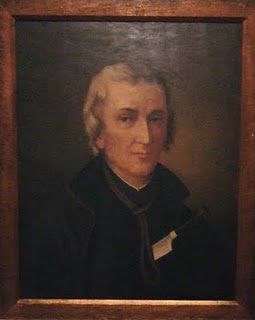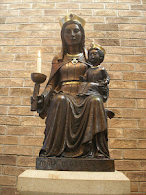 |
| THE EXECUTION OF ST JOHN KEMBLE |
John Kemble,
alias Holland, was born at Rhydicar Farm, St Weonard’s, Herefordshire in 1599.
He was the son of John Kemble and Anne Morgan. He and St David Lewis were
cousins. John Kemble’s mother, Anne Morgan, was a relative of David Lewis’s
father, Morgan Lewis. John was ordained a priest at Douai on 23rd February 1625
and, on 4th June, was sent upon the English Mission. He spent the next 54 years
labouring for the people of Herefordshire and Monmouthshire. He was greatly
loved by his own people and respected throughout the area because, it was said,
“he gave offence to none”.
In 1678, Fr
John Kemble became another innocent victim of the non-existent Popish Plot. A
lapsed Catholic, Captain John Scudamore of Kentchurch, was sent to arrest Fr
Kemble at Pembridge Castle, where the aged priest was staying with his
relatives. When urged to flee, the 80-year-old priest said, “According to
the course of nature I have but a few years to live. It will be an advantage to
suffer for my religion and therefore I will not abscond.” After three
months in Hereford Gaol, he endured an agonizing journey to London where he and
Fr David Lewis were lodged in Newgate Prison. They were interrogated by Oates
and his fellow plotters but, since no evidence of involvement in any plot could
be found, he was sent back to Hereford. In accordance with Statute 27 of
Elizabeth I, he was tried for treason, i.e., for being a Catholic priest and
saying Mass. He was found guilty and condemned to be hanged, drawn and
quartered.
On the
morning of his execution, Fr Kemble made his devotions as usual. He then drank
a cup of sack and smoked a pipe of tobacco with the undersheriff, Mr Digges, and
the prison governor. (This is the origin of the Herefordshire custom of calling
a parting drink or smoke a “Kemble Cup” or a “Kemble Pipe”.)
Before his execution on Widemarsh Common, the good priest forgave those who had
conspired against him and asked forgiveness of any whom he may have offended.
He consoled the distraught hangman thus, “Honest Anthony, my friend Anthony,
be not afraid; do thy office. I forgive thee with all my heart. Thou wilt do me
a greater kindness than discourtesy.” He prayed silently for a few minutes
then commended himself to God. The cart was drawn away and he was hanged. Such
was the affection for Fr Kemble that he was allowed to die upon the gallows
before being beheaded. He was also spared the grisly ritual of drawing and quartering.
It was said, even by his persecutors, that they never saw one die so like a
gentleman and so like a Christian.
When the
Martyr’s body was cut down from the scaffold, he fell with his hand beneath his
head. When he was beheaded, the hand was
also cut off. A devout woman in the
crowd picked up the hand and carried it home in her apron. For many years the hand was preserved in a
small red wood box. Eventually, it was
given to the Catholic Church of St Francis Xavier, Hereford. Near the end of the nineteenth century, a Mr
Monteith of Carstairs presented the parish with a magnificent jewel- studded
silver reliquary in which the hand now lies.
It can be seen today to the right of the High Altar.
.JPG) |
| The Martyr's severed hand |
On 25th
October 1970, St John Kemble and thirty-nine others were canonised by Pope Paul
VI as the Forty Martyrs of England and Wales.








.JPG)

.JPG)






A great man and saint. I have always like the 'Kemble pipe' aspect. Many thanks Breadgirl.
ReplyDeleteHello Richard
ReplyDeleteI think St John Kemble was an amazing man. From all accounts he accepted his fate with great calmness & just left everything in God's hands. Simply being eighty years old can be trial enough for some people & when you add to it all that John Kemble had to endure at that age it takes your breath away a little. I too love that 'Kemble Pipe' & the 'Kemble Cup' aspect.
We had a beautiful day at Usk on Sunday too. There were fewer than usual at the celebration in honour of St David Lewis but, hopefully, that will just be a temporary blip. Fr Adrian did a lovely job leading the services. Have a look at the short video in the post that follows this one.
Thanks Richard & God bless you.